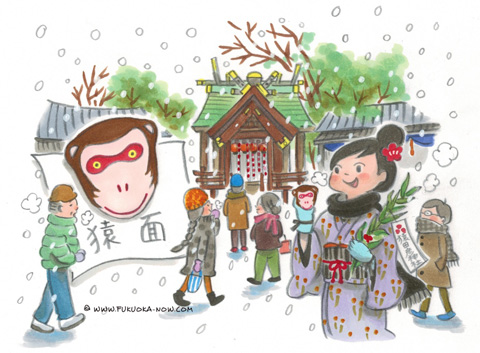Hakata Culture vol.131
Hatsu-koshin and Monkey Masks: An Interesting Combination of Old Beliefs

When you stroll around Fukuoka, you may notice some houses with monkey masks hanging over the entrance. These simple unglazed masks may have a whimsical appearance, but they are said to ward off evil spirits because the word for “monkey” (saru) is a homophone of the word for “go away.”
When Fukuokans need a monkey mask, they go to Sarutahiko Shrine in Fujisaki, Sawara Ward. This small shrine is usually quiet, but people line up to buy masks when koshin comes around. Koshin (also pronounced kanoesaru) is the 57th branch in the Chinese sexagenary cycle for counting days and years. Since it repeats every 60 days, there are six or seven koshin in a given year. The first koshin of the year, or hatsu-koshin, is thought to be the most auspicious, so a festival is held at Sarutahiko Shrine on this day. (In 2018, this will be January 28.)
Sarutahiko Okami, the god to which Sarutahiko Shrine is dedicated, is the god who guided the sun goddess Amaterasu’s grandson Ninigi-no-Mikoto on his descent to earth to create the Japanese archipelago. Originally, he was enshrined near the entrance to major roads as a dosojin (protector of travelers), and in fact where Sarutahiko Shrine is located in Fujisaki is the entrance to the old Karatsu Kaido road.
The custom of celebrating koshin came from China in the latter half of the 8th century. On the night of koshin, people would stay up all night because it was said that if you fell asleep, insects inside your body would crawl out and tell the gods about your sins. It is thought that these beliefs merged together because kanoesaru (the other term for koshin) and Sarutahiko both contain saru.
Although there are Sarutahiko Shrines all over Japan, the one in Fukuoka is the only place where you can procure monkey masks, which, by the way, are handcrafted by Hakata doll makers. In recent years, they have even become popular among test-taking students as a talisman against failure because of the old saying that “monkeys never fall from trees.”
厄を除ける猿面を求める初庚申
福岡の町を歩いていると、ときどき玄関先に猿のお面が掛けられているのを見かけます。この猿面には厄よけの意味が込められています。猿と同じ発音の「サル=去る」とかけて、“災いが去って、幸福が訪れる”という意味があるのです。素焼きの素朴な猿面はどことなくユーモラスな表情ですが、実は、悪いものが家の中に入ってこないように睨みをきかせているのです。
人々が猿面を買い求めるのが早良区藤崎にある猿田彦神社。ふだんはひっそりとした小さな神社ですが、庚申祭になると猿面を求めて多くの人が行列をつくります。「庚申」というのは中国から伝わった暦による干支で、60日ごとに年6~7回やってきます。とりわけ毎年最初の「初庚申」は縁起がいいとされ、猿田彦神社では初庚申大祭が行われます。2018年は1月28日が初庚申です。
神社に祀られている猿田彦大神は、天照大御神(アマテラスオオミカミ)に命じられて天孫降臨したニニギノミコトを道案内した神様です。もともとは道祖神として街道の出入り口に祀られてきた神様で、藤崎の猿田彦神社も佐賀県唐津に延びる唐津街道の入口にあります。
一方、庚申信仰は8世紀後半に中国から伝来した風習で、庚申の夜は眠ることなく夜を明かしました。眠ると体の中の虫が抜け出して、その人の罪を神様に告げ口されると言われたからです。庚申の「申=サル」と、猿田彦の「猿=サル」が同じことから、2つの信仰が結びついたと考えられています。
猿田彦神社は全国にありますが、猿面を授与しているのは福岡の神社だけ。この猿面は博多人形師による手作りです。最近では「猿は木から落ちない」ことから受験生にも人気があるのだそうです。

